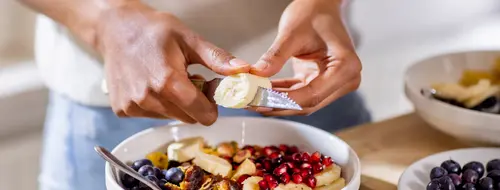What Is a Low-FODMAP Diet?
A low-FODMAP diet is designed to help people with irritable bowel syndrome (IBS) have better control over their symptoms by limiting certain foods. FODMAPs stands for fermentable oligo-saccharides, di-saccharides, mono-saccharides and polyols. Put more simply, FODMAPs are certain types of carbohydrates -- the sugars, starches, and fiber in foods.
For most, these foods are not a problem unless you eat too much of them. But some people are sensitive to them.
FODMAPs draw water into your digestive tract, which could make you bloated. If you eat too much of them, they can hang around in your gut and ferment.
These types of carbs are FODMAPs:
- Fructose: Fruits, honey, high-fructose corn syrup, agave
- Lactose: Dairy
- Fructans: Wheat, onions, garlic
- Galactans: Legumes, such as beans, lentils, and soybeans
- Polyols: Sugar alcohols and fruits that have pits or seeds, such as apples, avocados, cherries, figs, peaches, or plums
Avoiding FODMAPs doesn’t help everyone. But in a study published in the journal Gastroenterology, about 3 out of 4 people with IBS had their symptoms ease right away after starting a low-FODMAP diet and felt the most relief after 7 days or more on the plan.
Remember, FODMAPs aren't bad. Many foods that are rich in them encourage the growth of good bacteria in the gut.
Benefits of a Low-FODMAP Diet
Many people with IBS who use the low-FODMAP diet say it helps them. It may allow you to:
- Have fewer digestive symptoms, like gas, bloating, diarrhea, and constipation
- Manage your IBS symptoms without taking medicine
- Improve your quality of life
How to Follow a Low-FODMAP Diet
Your doctor or a dietitian who’s familiar with the low-FODMAP diet can help you. Using a low-FODMAP diet involves three steps: restriction, reintroduction, and personalization.
- Restriction: Under an expert’s guidance, you’ll stop eating certain foods for 6-8 weeks, to see if your symptoms improve.
- Reintroduction: Once your tummy calms down, you can bring back foods one at a time at a rate of one item per week, with guidance from your doctor or dietitian. You might discover that you’re sensitive to only one or two FODMAP carbs, not all of them.
- Personalization: You may have different reactions to some FODMAP carbs than other people. The goal is to figure out what foods trigger your digestive problems and create a diet that gives you all the nutrients you need but includes only the FODMAPs you can handle.
Foods Low and High in FODMAPs
You'll have many foods you can eat on this diet, but there's a steep learning curve about what items are high in FODMAPs and what you could choose instead.
Foods high in FODMAPs include:
- Anything made with wheat, barley, or rye
- Apples
- Artichokes
- Artificial sweeteners like in chewing gum
- Beans
- Cashews
- Cauliflower
- Dried fruits
- Garlic and onions
- High-fructose corn syrup
- Honey
- Ice cream
- Mushrooms
- Pistachios
- Watermelon
Foods low in FODMAPs include:
- Almond, coconut, rice, and soy milks
- Bananas
- Bell peppers
- Blueberries
- Carrots
- Cucumbers
- Grapes
- Oats
- Potatoes
- Quinoa
- Rice
- Spinach, kale, and other leafy greens
- Tangerines
- Tomatoes
It's good to work with a gastroenterologist (a doctor who works with the stomach and intestines) and with a dietitian who can help you limit FODMAPs but keep a balanced diet that meets all your nutritional needs.
Who Should Follow a Low-FODMAP Diet?
This diet may be a way for people with IBS to better control their symptoms. It isn’t a diet that people should try without a diagnosed gut condition, the way that people adopt a gluten-free diet without a medical need for that eating style. Consider this diet if:
- You’ve been diagnosed with IBS.
- You’re seeking a better way to control symptoms.
- You have inflammatory bowel disease (such as Crohn’s or ulcerative colitis) and you have digestive symptoms, even though your condition is inactive.
